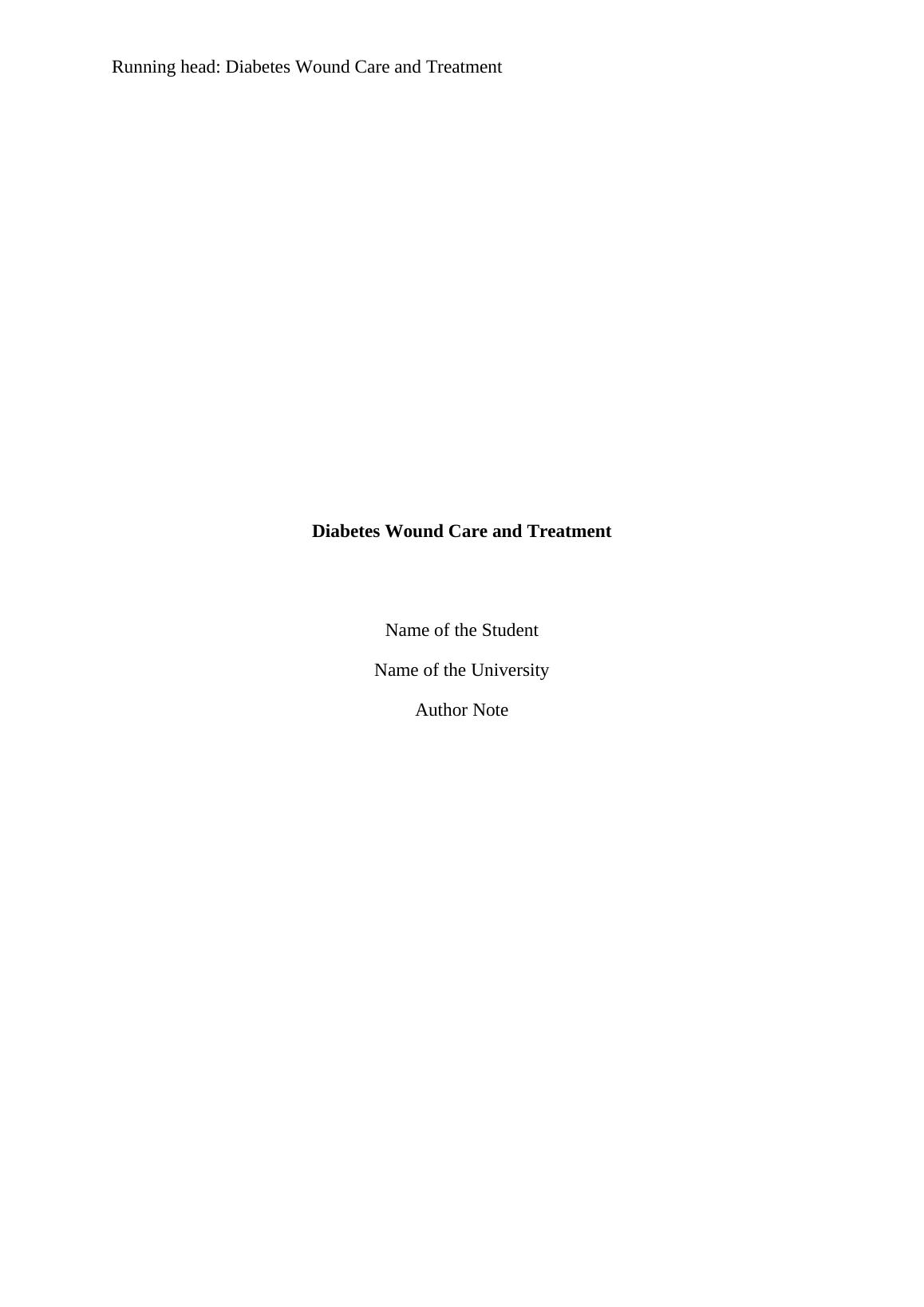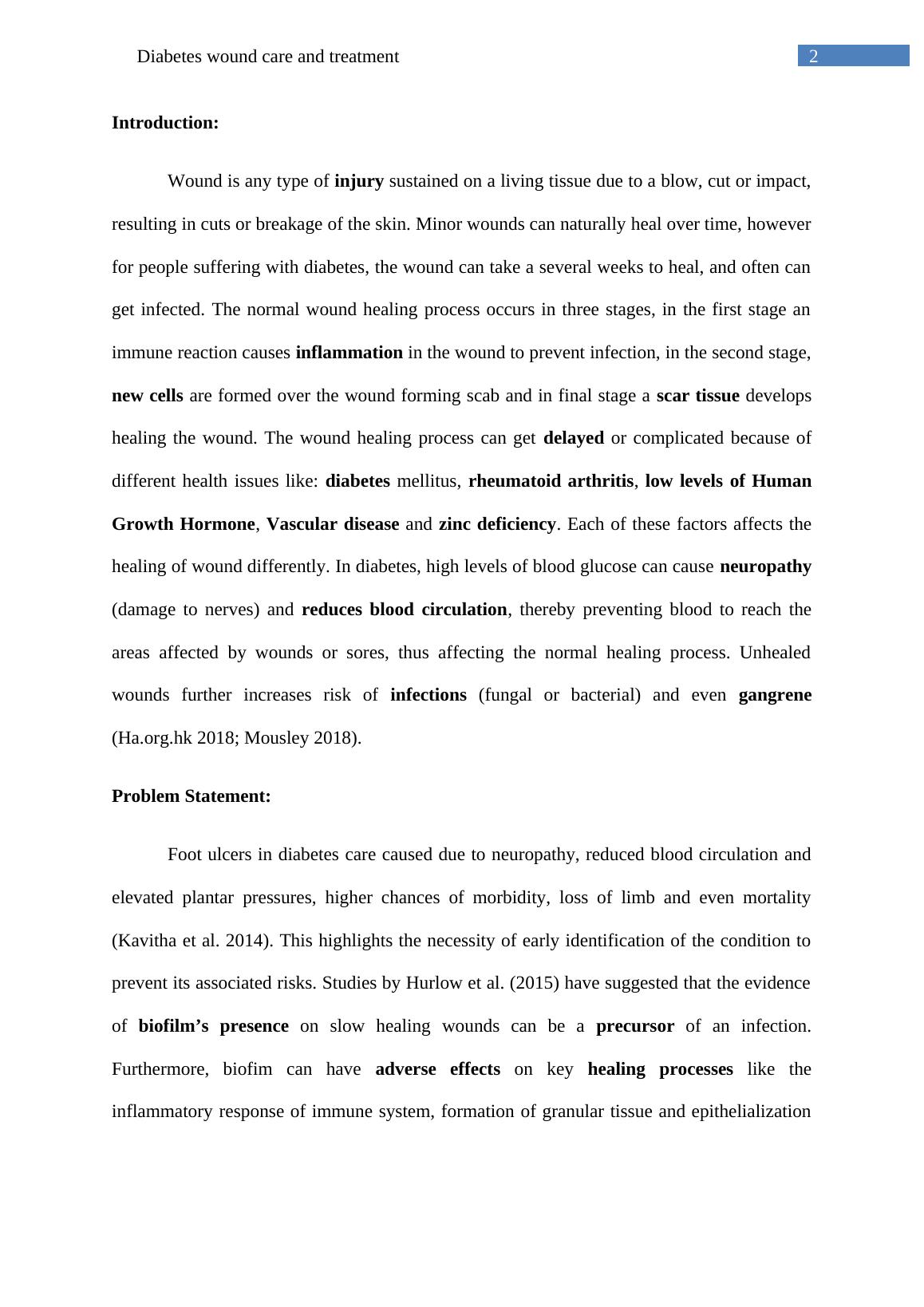Diabetic Wound Care Assignment
Added on 2021-04-24
15 Pages3567 Words69 Views
Running head: Diabetes Wound Care and TreatmentDiabetes Wound Care and TreatmentName of the StudentName of the UniversityAuthor Note

1Diabetes wound care and treatmentContentsIntroduction:...............................................................................................................................2Problem Statement:....................................................................................................................2Research Objectives/Questions:.................................................................................................3Literature Review:......................................................................................................................3Biofilms:.................................................................................................................................3Diabetic Foot Ulcer DFU:......................................................................................................5Research Design and Methodology:..........................................................................................7Ethical Considerations:..............................................................................................................9Conclusion:................................................................................................................................9

2Diabetes wound care and treatmentIntroduction:Wound is any type of injury sustained on a living tissue due to a blow, cut or impact,resulting in cuts or breakage of the skin. Minor wounds can naturally heal over time, howeverfor people suffering with diabetes, the wound can take a several weeks to heal, and often canget infected. The normal wound healing process occurs in three stages, in the first stage animmune reaction causes inflammation in the wound to prevent infection, in the second stage,new cells are formed over the wound forming scab and in final stage a scar tissue developshealing the wound. The wound healing process can get delayed or complicated because ofdifferent health issues like: diabetes mellitus, rheumatoid arthritis, low levels of HumanGrowth Hormone, Vascular disease and zinc deficiency. Each of these factors affects thehealing of wound differently. In diabetes, high levels of blood glucose can cause neuropathy(damage to nerves) and reduces blood circulation, thereby preventing blood to reach theareas affected by wounds or sores, thus affecting the normal healing process. Unhealedwounds further increases risk of infections (fungal or bacterial) and even gangrene(Ha.org.hk 2018; Mousley 2018).Problem Statement:Foot ulcers in diabetes care caused due to neuropathy, reduced blood circulation andelevated plantar pressures, higher chances of morbidity, loss of limb and even mortality(Kavitha et al. 2014). This highlights the necessity of early identification of the condition toprevent its associated risks. Studies by Hurlow et al. (2015) have suggested that the evidenceof biofilm’s presence on slow healing wounds can be a precursor of an infection.Furthermore, biofim can have adverse effects on key healing processes like theinflammatory response of immune system, formation of granular tissue and epithelialization

3Diabetes wound care and treatment(Seth et al. 2012). This poses an important question “can biofilm be useful in the earlydetection of infection in diabetic foot ulcers?”Research Objectives/Questions: The objective of the research is to study whether presence of biofilm can be used forearly slow healing foot ulcers in diabetic patients and what treatment/management strategiescan be used to minimize the risk of morbidity and mortality due to it.Literature Review:Through a systematic review of literature, several aspects were highlighted thatrequires further studies to be done in the field of diabetic wound management. These aspectsare arranged thematically:Biofilms:Studies by Harlow et al. (2015) suggested that slow healing wounds often developbiofilm, which can be a precursor of an infection. Biofilms can be understood as a wellstructured microbial community existing in a polymeric matrix that is created by themicrobes (called extracellular polymeric substances EPS) stuck to a living or inert surface(Flemming et al. 2015). Seth et al. (2012) also supported that biofilm bacteria are moreresistant to the immune reaction of the host as well as antiseptics and antibiotics, incomparison to planktonic bacteria, which increases the risks of wound infection.Furthermore, local inflammatory response to biofilm and microbial toxin can further causedamage to the tissues, and the biofilm can spread by ‘seeding’ to adjacent surfaces to thewound, forming new microbial colonies (Philips and Schultz 2012; Kaplan, Meyenhofer andFine 2003). Hurlow and Bowler (2012) added that poor moisture or poor control of exudatesin the environment can lead to the formation of a biofilm. Multispecies biofilm also have

End of preview
Want to access all the pages? Upload your documents or become a member.
Related Documents
Diabetic wound care in diabetic patientslg...
|28
|8753
|478
Diabetic Wound Care: Causes, Biofilm Formation, and Treatmentlg...
|21
|1476
|371
Wound Assessment and Management Plan for Diabetic Foot Ulcer Patientlg...
|9
|2631
|284
Pathophysiological Assessment and Nursing Care Priorities on Case Study Reviewlg...
|9
|2534
|342
Nursing Assignment-Diabetic Case Studylg...
|10
|2911
|36
Foot Ulcer and Diabetes: Pathophysiology, Impact, and Management Strategieslg...
|10
|2503
|487
